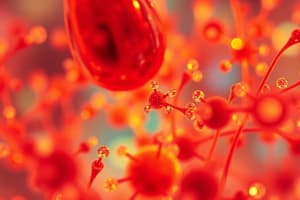Podcast
Questions and Answers
What is the main function of the condenser in a light microscope?
What is the main function of the condenser in a light microscope?
- To adjust the focus of the specimen
- To enlarge the image of the specimen
- To collect and focus illumination (correct)
- To project the image onto the viewer's retina
What is the maximum resolving power achievable by a light microscope?
What is the maximum resolving power achievable by a light microscope?
- 1 μm
- 10 μm
- 0.5 μm
- 0.1 μm (correct)
Which part of the light microscope is responsible for further magnifying the image after the objective lens?
Which part of the light microscope is responsible for further magnifying the image after the objective lens?
- Stage
- Mirror
- Ocular lens (correct)
- Condenser
Why is magnification considered of value only when accompanied by high resolution?
Why is magnification considered of value only when accompanied by high resolution?
What adjustment should be made to secure a sharp focus on the specimen after initial focusing?
What adjustment should be made to secure a sharp focus on the specimen after initial focusing?
What is a key advantage of phase contrast microscopy?
What is a key advantage of phase contrast microscopy?
Which of the following is NOT part of the mechanical components of a light microscope?
Which of the following is NOT part of the mechanical components of a light microscope?
How is total magnification calculated in a light microscope?
How is total magnification calculated in a light microscope?
What is the role of the interference microscope in microscopy?
What is the role of the interference microscope in microscopy?
In confocal microscopy, what advantage does the method provide for examining specimens?
In confocal microscopy, what advantage does the method provide for examining specimens?
What is birefringence in the context of polarizing microscopy?
What is birefringence in the context of polarizing microscopy?
What characteristic of fluorescence microscopy allows for the localization of nucleic acids?
What characteristic of fluorescence microscopy allows for the localization of nucleic acids?
What is a major benefit of using electron microscopy?
What is a major benefit of using electron microscopy?
Which of the following substances can naturally fluoresce when exposed to ultraviolet light?
Which of the following substances can naturally fluoresce when exposed to ultraviolet light?
How does a differential interference microscope enhance imaging?
How does a differential interference microscope enhance imaging?
What does the fluorescence microscope use to protect the observer's eyes during imaging?
What does the fluorescence microscope use to protect the observer's eyes during imaging?
Flashcards are hidden until you start studying
Study Notes
Light Microscopy
- Light microscopy uses stained sections examined through transillumination.
- Composed of mechanical parts (focus adjustment knob, stage position adjustment, and stage) and optical components (condenser, objective lens, ocular lens).
- The condenser lens focuses light to illuminate the specimen, while the objective lens enlarges the image. The ocular lens magnifies it further.
- Total magnification = magnifying power of objective lens × magnifying power of ocular lens.
- Maximal resolution is around 0.1 μm, allowing magnification of 1000-1500 times.
- High resolution is critical for effective magnification; resolving power depends on the quality of the objective lens.
Instructions for Using a Light Microscope
- Turn on the light and place the specimen on the stage.
- Use low-power objective with coarse adjustment to focus.
- Ensure the iris diaphragm is widely open for optimal illumination.
- Observe the field through the oculars for even lighting.
- Use coarse adjustment for initial focus, then fine adjustment for sharp focus.
Types of Microscopes
Phase Contrast Microscopy
- Enables examination of unstained cells and tissues, beneficial for living cells.
- Works on light speed changes through structures with different refractive indices.
- Dense areas appear dark while less dense areas appear light.
- Modifications include interference microscopy (quantifies tissue mass) and differential interference microscopy (assesses surface properties).
Confocal Microscopy
- Utilizes lasers and computers to produce 3D images of living specimens.
- Allows visual dissection through specimens, revealing internal structures.
- Stores information from thin sections to reconstruct 3D images.
Polarizing Microscopy
- Features polarizing filters (polarizer and analyzer) positioned between light source and specimen, and between objective lens and viewer, respectively.
- Birefringence from rotating polarized light, identifying crystalline substances or oriented molecules such as collagen and muscle fibers.
Fluorescence Microscopy
- Uses ultraviolet light to excite certain molecules that emit visible light.
- Fluorescent substances appear as bright particles on a dark background.
- Employs special filters to protect eyes from UV light.
- Fluorescent compounds include naturally fluorescent substances and synthetic dyes like acridine orange, which labels DNA and RNA, emitting distinct colors for localization.
Electron Microscopy
- Offers theoretical resolution of 0.1 nm, significantly surpassing light microscopy resolution.
- Ideal for detailed visualization of cellular structures at the nanometer scale.
Studying That Suits You
Use AI to generate personalized quizzes and flashcards to suit your learning preferences.




